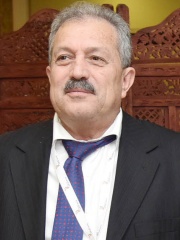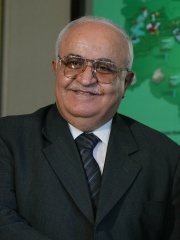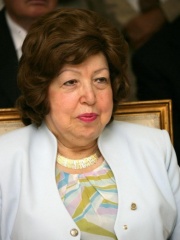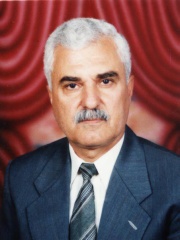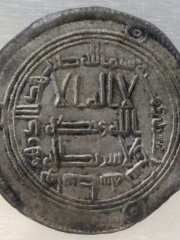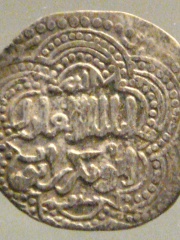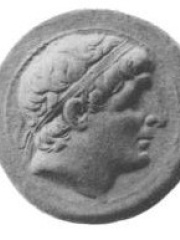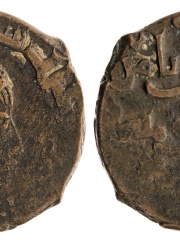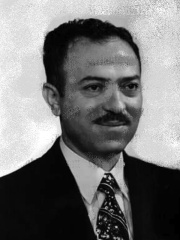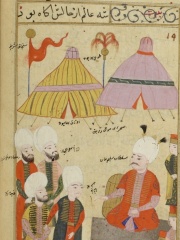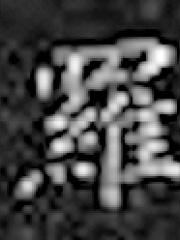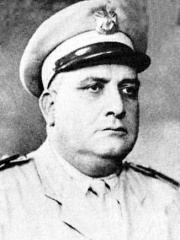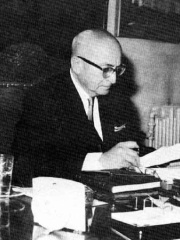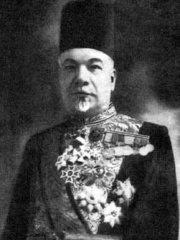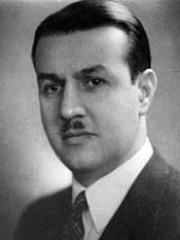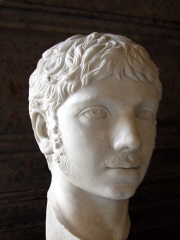

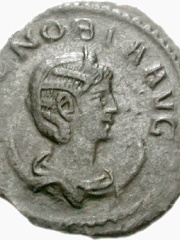
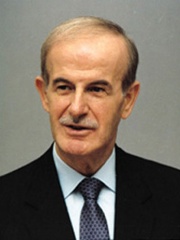
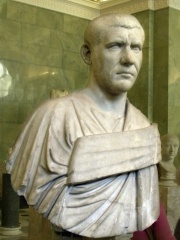

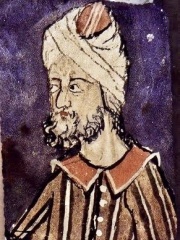
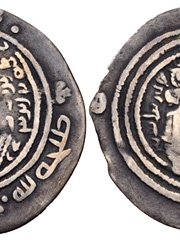
The Most Famous
POLITICIANS from Syria
This page contains a list of the greatest Syrian Politicians. The pantheon dataset contains 19,576 Politicians, 82 of which were born in Syria. This makes Syria the birth place of the 39th most number of Politicians behind Argentina, and Brazil.
Top 10
The following people are considered by Pantheon to be the top 10 most legendary Syrian Politicians of all time. This list of famous Syrian Politicians is sorted by HPI (Historical Popularity Index), a metric that aggregates information on a biography’s online popularity. Visit the rankings page to view the entire list of Syrian Politicians.

1. Elagabalus (203 - 222)
With an HPI of 76.48, Elagabalus is the most famous Syrian Politician. His biography has been translated into 79 different languages on wikipedia.
Marcus Aurelius Antoninus (born Sextus Varius Avitus Bassianus, c. 204 – 11/12 March 222), better known by his nicknames Elagabalus (, EL-ə-GAB-ə-ləs) and Heliogabalus ( HEE-lee-ə-, -lee-oh-), was Roman emperor from 218 to 222, while he was still a teenager. His short reign was notorious for sex scandals and religious controversy. A close relative to the Severan dynasty, he came from a prominent Arab family in Emesa (Homs), Syria, where since his early youth he served as head priest of the sun god Elagabal. After the death of his cousin, the emperor Caracalla, Elagabalus was raised to the principate at 14 years of age in an army revolt instigated by his grandmother Julia Maesa against Caracalla's short-lived successor, Macrinus. He only posthumously became known by the Latinised name of his god.Later historians suggest Elagabalus showed a disregard for Roman religious traditions and sexual taboos. He replaced the traditional head of the Roman pantheon, Jupiter, with the deity Elagabal, of whom he had been high priest. He forced leading members of Rome's government to participate in religious rites celebrating this deity, presiding over them in person. He married four women, including a Vestal Virgin, in addition to lavishing favours on male courtiers thought to have been his lovers. He was also reported to have prostituted himself. His behavior estranged the Praetorian Guard, the Senate and the common people alike. Amidst growing opposition, at just 18 years of age he was assassinated and replaced by his cousin Severus Alexander in March 222. The assassination plot against Elagabalus was devised by Julia Maesa and carried out by disaffected members of the Praetorian Guard. Elagabalus developed a reputation among his contemporaries for extreme eccentricity, decadence, zealotry and sexual promiscuity. This tradition has persisted; among writers of the early modern age he endured one of the worst reputations among Roman emperors. Edward Gibbon, notably, wrote that Elagabalus "abandoned himself to the grossest pleasures with ungoverned fury". According to Barthold Georg Niebuhr, "“the name of Elagabalus is branded in history above all others; [...] "Elagabus had nothing at all to make up for his vices, which are of such a kind that it is too disgusting even to allude to them." An example of a modern historian's assessment is Adrian Goldsworthy's: "Elagabalus was not a tyrant, but he was an incompetent, probably the least able emperor Rome had ever had." Despite near-universal condemnation of his reign, some scholars write warmly about his religious innovations, including the 6th-century Byzantine chronicler John Malalas, as well as Warwick Ball, a modern historian who described him as "a tragic enigma lost behind centuries of prejudice".

2. Yazid I (647 - 683)
With an HPI of 73.49, Yazid I is the 2nd most famous Syrian Politician. His biography has been translated into 55 different languages.
Yazid ibn Mu'awiya ibn Abi Sufyan (Arabic: يزيد بن معاوية بن أبي سفيان, romanized: Yazīd ibn Muʿāwiya ibn ʾAbī Sufyān; c. 646 – 11 November 683), commonly known as Yazid I, was the second caliph of the Umayyad Caliphate. He ruled from April 680 until his death in November 683. His appointment by his father Mu'awiya I was the first hereditary succession to the caliphate in Islamic history. His caliphate was marked by the death of Muhammad's grandson Husayn ibn Ali and the start of the crisis known as the Second Fitna. During his father's caliphate, Yazid led several campaigns against the Byzantine Empire, including an attack on the Byzantine capital, Constantinople. Yazid's nomination as heir apparent in 676 CE (56 AH) by Mu'awiya was opposed by several Muslim grandees from the Hejaz region, including Husayn and Abd Allah ibn al-Zubayr. The two men refused to recognize Yazid following his accession and took sanctuary in Mecca. When Husayn left for Kufa in Iraq to lead a revolt against Yazid, he was killed with his small band of supporters by Yazid's forces in the Battle of Karbala. Husayn's death caused resentment in the Hejaz, where Ibn al-Zubayr called for a consultative assembly to elect a new caliph. The people of Medina, who supported Ibn al-Zubayr, held other grievances toward the Umayyads. After failing to gain the allegiance of Ibn al-Zubayr and the people of the Hejaz through diplomacy, Yazid sent an army to suppress their rebellion. The army defeated the Medinese in the Battle of al-Harra in August 683 and the city was sacked. Afterward, Mecca was besieged for several weeks until the army withdrew as a result of Yazid's death in November 683. The Caliphate fell into a nearly decade-long civil war, ending with the establishment of the Marwanid dynasty (the Umayyad caliph Marwan I and his descendants). Yazid continued Mu'awiya's decentralized model of governance, relying on his provincial governors and the tribal nobility. He abandoned Mu'awiya's ambitious raids against the Byzantine Empire and strengthened Syria's military defences. No new territories were conquered during his reign. Yazid is considered an illegitimate ruler and a tyrant by many Muslims due to his hereditary succession, the death of Husayn, and his attack on Medina. Modern historians take a milder view, and consider him a capable ruler, albeit less successful than his father.

3. Zenobia (240 - 275)
With an HPI of 73.30, Zenobia is the 3rd most famous Syrian Politician. Her biography has been translated into 55 different languages.
Septimia Zenobia (Palmyrene Aramaic: 𐡡𐡶𐡦𐡡𐡩, Bat-Zabbai; c. 240 – c. 274) was a third-century queen of the Palmyrene Empire in Syria. Many legends surround her ancestry; she was probably not a commoner and she married the ruler of the city, Odaenathus. Her husband became king in 260, elevating Palmyra to supreme power in the Near East by defeating the Sasanian Empire of Persia and stabilizing the Roman East. After Odaenathus' assassination, Zenobia became the regent of her son Vaballathus and held de facto power throughout his reign. In 270, Zenobia launched an invasion that brought most of the Roman East under her sway and culminated with the annexation of Egypt. By mid-271 her realm extended from Ancyra, central Anatolia, to Upper Egypt, although she remained nominally subordinate to Rome. However, in reaction to the campaign of the Roman emperor Aurelian in 272, Zenobia declared her son emperor and assumed the title of empress, thus declaring Palmyra's secession from Rome. The Romans were victorious after heavy fighting; the empress was besieged in her capital and captured by Aurelian, who exiled her to Rome, where she spent the remainder of her life. Zenobia was a cultured monarch and fostered an intellectual environment in her court, which was open to scholars and philosophers. She was tolerant toward her subjects and protected religious minorities. The empress maintained a stable administration, which governed a multicultural, multiethnic empire. Zenobia died after 274, and many tales have been recorded about her fate. Her rise and fall have inspired historians, artists and novelists, and she is a patriotic symbol in Syria.

4. Hafez al-Assad (1930 - 2000)
With an HPI of 72.15, Hafez al-Assad is the 4th most famous Syrian Politician. His biography has been translated into 80 different languages.
Hafez al-Assad (6 October 1930 – 10 June 2000) was a Syrian statesman, military officer and revolutionary who served as the 18th president of Syria from 1971 until his death in 2000. He had previously served as prime minister of Syria from 1970 to 1971 as well as regional secretary of the regional command of the Syrian regional branch of the Arab Socialist Ba'ath Party and secretary general of the National Command of the Ba'ath Party from 1970 to 2000. Hafez al-Assad was a key participant in the 1963 Syrian coup d'état, which brought the Syrian regional branch of the Arab Socialist Ba'ath Party to power in the country. The new leadership appointed Hafez as the commander of the Syrian Air Force. In February 1966 Hafez participated in a second coup, which toppled the traditional leaders of the Ba'ath Party. Hafez was appointed defence minister by the new government. Four years later Hafez initiated a third coup, which ousted the de facto leader Salah Jadid, and appointed himself as leader of Syria. Hafez imposed various changes to the Ba'athist government when he took power. He subordinated state socialism for a mixed economic model and defended private property. Hafez also abandoned the rhetoric of exporting "socialist revolution" by strengthening Syria's foreign relations with countries that his predecessor had deemed reactionary. Hafez sided with the Soviet Union and the Eastern Bloc during the Cold War in return for support against Israel and, whilst he had forsaken the pan-Arab concept of unifying the Arab world into one Arab nation, he sought to paint Syria as the defender of the Palestinians against Israel. When he came to power Hafez organised the state along sectarian lines. (Sunnis and non-Alawites became figure-heads of political institutions whilst the Alawites took control of the military, intelligence, bureaucracy and security apparatuses.) Ba'athist decision-making authority that had previously been collegial was reduced and given to the Syrian president. The Syrian government ceased to be a one-party system in the normal sense of the word and was turned into a one-party dictatorship with a strong presidency. To maintain this system, a cult of personality centred on Hafez and his family was created by the president and the Ba'ath party. The Assad family’s personality cult was integrated with the Ba’athist doctrine to shape the state's official ideology. Hafez ordered an intervention in Lebanon in 1976, which resulted in the Syrian occupation of Lebanon. During his rule Hafez crushed an Islamist uprising led by the Syrian Muslim Brotherhood rebels through a series of crackdowns culminating in the Hama massacre. After consolidating his personal authority over the Syrian government Hafez began looking for a successor. His first choice was his brother Rifaat, but Rifaat attempted to seize power in 1983–1984 when Hafez's health was in doubt. Rifaat was subsequently exiled when Hafez's health recovered. Hafez's next choice of successor was his eldest son, Basil. However Basil died in a car accident in 1994 and Hafez turned to his third choice—his younger son Bashar, who at that time had no political experience. The move to appoint a member of his own family as his successor was met with criticism in some quarters of the Syrian ruling class, but Hafez persisted with his plan and demoted officials who opposed this succession. Hafez died in 2000 and Bashar succeeded him as president. Under his rule the country would later collapse into civil war.

5. Abd al-Rahman I (731 - 788)
With an HPI of 72.09, Abd al-Rahman I is the 5th most famous Syrian Politician. His biography has been translated into 56 different languages.
Abd al-Rahman ibn Mu'awiya ibn Hisham (Arabic: عبد الرحمن إبن معاوية إبن هشام; 7 March 731 – 30 September 788), commonly known as Abd al-Rahman I, was the founder of the Umayyad dynasty that ruled the greater part of Iberia in Al-Andalus for nearly three centuries (including the succeeding Caliphate of Córdoba). Abd al-Rahman was a member of the Umayyad dynasty in Damascus, and his establishment of a government in Iberia represented a break with the Abbasids, who had overthrown the Umayyads in Damascus in 750. He was also known by the surnames al-Dakhil ("the Immigrant"), Saqr Quraysh ("the Falcon of Quraysh").

6. Philip the Arab (204 - 249)
With an HPI of 71.07, Philip the Arab is the 6th most famous Syrian Politician. His biography has been translated into 71 different languages.
Philip the Arab (Latin: Marcus Julius Philippus "Arabs"; c. 204 – September 249) was Roman emperor from 244 to 249. He was born in Aurantis, Arabia, in a city situated in modern-day Syria. After the death of Gordian III in February 244, Philip, who had been Praetorian prefect, achieved power. He quickly negotiated peace with the Persian Sassanid Empire and returned to Rome to be confirmed by the Senate. During his reign, the city of Rome celebrated its millennium. Philip was betrayed and killed at the Battle of Verona in September 249 following a rebellion led by his successor, Gaius Messius Quintus Decius. Philip's reign of five years was uncommonly stable in a turbulent third century.During the late 3rd century and into the 4th, it was held by some churchmen that Philip had been the first Christian emperor; he was described as such in Jerome's Chronicon (Chronicle), which was well known during the Middle Ages, in Orosius' highly popular Historia Adversus Paganos (History Against the Pagans), and was presented as a Christian in Eusebius of Caesarea's Historia Ecclesiastica (Ecclesiastical History). Modern scholars are divided on the issue.

7. Bashar al-Assad (b. 1965)
With an HPI of 70.85, Bashar al-Assad is the 7th most famous Syrian Politician. His biography has been translated into 111 different languages.
Bashar al-Assad (born 11 September 1965) is a Syrian politician who is the current and 19th president of Syria since 17 July 2000. In addition, he is the commander-in-chief of the Syrian Armed Forces and the secretary-general of the Central Command of the Arab Socialist Ba'ath Party, which nominally espouses a neo-Ba'athist ideology. His father and predecessor was General Hafiz al-Assad, whose presidency in 1971–2000 marked the transfiguration of Syria from a republican state into a de facto dynastic dictatorship, tightly controlled by an Alawite-dominated elite composed of the armed forces and the Mukhabarat (secret services), who are loyal to the al-Assad family. Born and raised in Damascus, Bashar graduated from the medical school of Damascus University in 1988 and began to work as a doctor in the Syrian Army. Four years later, he attended postgraduate studies at the Western Eye Hospital in London, specialising in ophthalmology. In 1994, after his elder brother Bassel died in a car accident, Bashar was recalled to Syria to take over Bassel's role as heir apparent. He entered the military academy, taking charge of the Syrian occupation of Lebanon in 1998. On 17 July 2000, Bashar al-Assad became president, succeeding his father Hafiz, who had died on 10 June 2000. A series of crackdowns in 2001–02 ended the Damascus Spring, a period of cultural and political activism marked by calls for transparency and democracy. Although Bashar inherited the power structures and personality cult nurtured by Hafiz al-Assad, he lacked the loyalty received by his father, which led to rising discontent against his rule. As result, many members of the Old Guard resigned or were purged; and the inner-circle were replaced by staunch loyalists from Alawite clans. Bashar al-Assad's early economic liberalisation programs worsened inequalities and centralized the socio-political power of the loyalist Damascene elite of the Assad family; alienating the Syrian rural population, urban working classes, businessmen, industrialists and people from once-traditional Ba'ath strongholds. The Cedar Revolution in Lebanon in February 2005, triggered by the assassination of Lebanese Prime Minister Rafic Hariri, forced Bashar al-Assad to end Syrian occupation of Lebanon. Assad's regime is a highly personalist dictatorship, which governs Syria as a totalitarian police state. Bashar al-Assad's reign has been characterised by numerous human rights violations and severe repression. While the Assad government describes itself as secular, various political scientists and observers note that his regime exploits sectarian tensions in the country. The first decade in power was marked by intense censorship, summary executions, forced disappearances, discrimination of ethnic minorities and extensive surveillance by the Ba'athist secret police. The United States, the European Union, and majority of the Arab League called for Assad's resignation from the presidency in 2011 after he ordered a violent crackdown on Arab Spring protesters during the events of the Syrian revolution, which led to the Syrian civil war. The civil war has killed around 580,000 people, of which a minimum of 306,000 deaths are non-combatant, with pro-Assad forces causing more than 90% of the civilian deaths. The war has also forcibly displaced 14 million Syrians, with over 7 million refugees, causing the largest refugee crisis in the world. An additional 154,000 civilians have been forcibly disappeared or subject to arbitrary detentions; with over 135,000 individuals being tortured, imprisoned, or dead in government detention centres as of 2023.The Assad regime's perpetration of numerous war crimes and crimes against humanity during the civil war has led to international condemnation and isolation. The Syrian military is estimated to have conducted over 300 chemical attacks, with UN investigations confirming at least nine chemical attacks conducted by pro-Assad forces. The deadliest incident was a chemical attack in Ghouta on 21 August 2013, which caused the deaths of 1,100–1,500 civilians. In December 2013, the UN High Commissioner for Human Rights Navi Pillay stated that findings from an inquiry by the UN implicated Assad in war crimes. Investigations by the OPCW-UN Joint Investigative Mechanism and OPCW-UN IIT concluded that the Assad government was responsible for the 2017 Khan Shaykhun sarin attack and 2018 Douma chemical attack respectively. In June 2014, the American Syrian Accountability Project included Assad on a list of war crimes indictments of government officials and sent it to the International Criminal Court. In 2023, Canada and the Netherlands filed a joint lawsuit at the International Court of Justice accusing the Assad government of infringing UN Convention Against Torture. On 15 November 2023, France issued an arrest warrant against Assad over the use of banned chemical weapons against civilians in Syria. Assad has categorically denied the allegations of these charges and has accused foreign countries, especially the American-led intervention in Syria, of purportedly attempting regime change.

8. Imad ad-Din Zengi (1087 - 1146)
With an HPI of 70.71, Imad ad-Din Zengi is the 8th most famous Syrian Politician. His biography has been translated into 46 different languages.
Imad al-Din Zengi (Arabic: عماد الدین زنكي; c. 1085 – 14 September 1146), also romanized as Zangi, Zengui, Zenki, and Zanki, was a Turkoman atabeg of the Seljuk Empire, who ruled Mosul, Aleppo, Hama, and, later, Edessa. He was the namesake and founder of the Zengid dynasty of atabegs.

9. Muawiya II (661 - 684)
With an HPI of 69.02, Muawiya II is the 9th most famous Syrian Politician. His biography has been translated into 47 different languages.
Mu'awiya ibn Yazid ibn Mu'awiya (Arabic: مُعَاوِيَة بْنِ يَزِيد بْنِ مُعَاوِيَة, romanized: Muʿāwiya ibn Yazīd ibn Muʿāwiya; c. 664–684), commonly known as Mu'awiya II, was the third Umayyad caliph, ruling for less than a year in 683–684. He succeeded his father Yazid I as the third caliph and last caliph of the Sufyanid line in the Umayyad dynasty. He ruled briefly in 683–684 (64 AH) before he died.
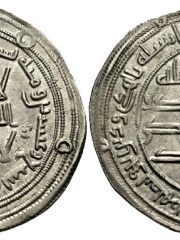
10. Marwan II (688 - 750)
With an HPI of 68.87, Marwan II is the 10th most famous Syrian Politician. His biography has been translated into 42 different languages.
Marwan ibn Muhammad ibn Marwan (Arabic: مروان بن محمد بن مروان, romanized: Marwān ibn Muḥammad ibn Marwān; c. 691– 6 August 750), commonly known as Marwan II, was the fourteenth and last caliph of the Umayyad Caliphate, ruling from 744 until his death. His reign was dominated by a civil war, and he was the last Umayyad ruler to rule the united Caliphate before the Abbasid Revolution toppled the Umayyad dynasty.
People
Pantheon has 95 people classified as Syrian politicians born between 1850 BC and 2009. Of these 95, 22 (23.16%) of them are still alive today. The most famous living Syrian politicians include Bashar al-Assad, Levon Ter-Petrosyan, and Hussein Arnous. The most famous deceased Syrian politicians include Elagabalus, Yazid I, and Zenobia. As of April 2024, 13 new Syrian politicians have been added to Pantheon including As-Salih Ismail al-Malik, Ahmad al-Khatib, and Hayır Bey.
Living Syrian Politicians
Go to all RankingsBashar al-Assad
1965 - Present
HPI: 70.85
Levon Ter-Petrosyan
1945 - Present
HPI: 62.87
Hussein Arnous
1953 - Present
HPI: 56.99
Salih Muslim
1951 - Present
HPI: 56.04
Muhammad Naji al-Otari
1944 - Present
HPI: 52.43
Najah al-Attar
1933 - Present
HPI: 52.00
Salim Idris
1957 - Present
HPI: 50.88
George Sabra
1947 - Present
HPI: 49.80
Ali Abdullah Ayyoub
1952 - Present
HPI: 49.58
Burhan Ghalioun
1945 - Present
HPI: 48.06
Ali Farzat
1951 - Present
HPI: 47.43
Bushra al-Assad
1960 - Present
HPI: 46.96
Deceased Syrian Politicians
Go to all RankingsElagabalus
203 - 222
HPI: 76.48
Yazid I
647 - 683
HPI: 73.49
Zenobia
240 - 275
HPI: 73.30
Hafez al-Assad
1930 - 2000
HPI: 72.15
Abd al-Rahman I
731 - 788
HPI: 72.09
Philip the Arab
204 - 249
HPI: 71.07
Imad ad-Din Zengi
1087 - 1146
HPI: 70.71
Muawiya II
661 - 684
HPI: 69.02
Marwan II
688 - 750
HPI: 68.87
Hisham ibn Abd al-Malik
691 - 743
HPI: 66.04
Al-Adil I
1145 - 1218
HPI: 66.03
Antiochus II Theos
286 BC - 246 BC
HPI: 65.16
Newly Added Syrian Politicians (2024)
Go to all RankingsAs-Salih Ismail al-Malik
1163 - 1181
HPI: 58.70
Ahmad al-Khatib
1933 - 1982
HPI: 55.45
Hayır Bey
1464 - 1522
HPI: 54.33
Alopen
600 - Present
HPI: 51.52
Sami al-Hinnawi
1898 - 1950
HPI: 51.08
Rezin
HPI: 50.93
Khalid al-Azm
1903 - 1965
HPI: 49.63
Muhammad Ali Bey al-Abid
1867 - 1939
HPI: 48.27
Muhammad Mustafa Mero
1941 - 2020
HPI: 48.06
Suat Hayri Ürgüplü
1903 - 1981
HPI: 47.35
Bushra al-Assad
1960 - Present
HPI: 46.96
Abdulbaset Sieda
1956 - Present
HPI: 45.38
Overlapping Lives
Which Politicians were alive at the same time? This visualization shows the lifespans of the 25 most globally memorable Politicians since 1700.


